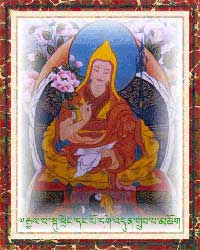1st Dalai Lama
Gendun Drup (1391–1474), also known as Gendun Drub (dge 'dun grub pa) and Kundun Drup, is considered retrospectively to be the first of the Dalai Lamas of Tibet, who are believed to be reincarnations of Chenresig (Sanskrit: Avalokiteshvara), the Bodhisattva of Compassion.
Biography
Gendun Drup was born in a cowshed in Gyurmey Rupa, near Sakya in the Tsang region of central Tibet, the son of Gonpo Dorjee and Jomo Namkha Kyi, nomadic tribes people.
He was raised as a shepherd until the age of seven. His birth name (according to the Tibetan Buddhist Resource Center, his personal name) was Pema Dorje (Tibetan:
པད་མ་རྡོ་རྗེ་, Wylie: pad ma rdo rje, Vajra Lotus/Lotus Vajra). Later, he was placed in Nartang Monastery(Nar-thang). In 1405, he took his novice vows from the abbot of Narthang, Khenchen Drupa Sherab.
When he was 20 years old, in about 1411, he received the name Gendun Drubpa upon taking the vows of a fully ordained monk, or Gelong, from the abbot of Narthang Monastery.
Also at this age, he became a student of the great scholar and reformer Tsongkhapa (1357–1419), who some say was his uncle.
Around this time he also became the first abbot of Ganden Monastery, founded by Tsongkhapa himself in 1409.
By the middle of his life, Gendun Drup had become one of the most esteemed scholar-saints in the country.
Tradition states that Palden Lhamo, the female guardian spirit of the sacred lake, Lhamo La-tso, promised the First Dalai Lama in one of his visions "...that she would protect the reincarnation lineage of the Dalai Lamas."
Since the time of the Second Dalai Lama Gendun Gyatso, who formalized the system, monks have gone to the lake to meditate when seeking visions with guidance on finding the next reincarnation.
Gendun Drubpa founded two major monasteries: Drepung and Tashillhunpo.
In 1447, Gendun Drup founded the great monastery of Tashilhunpo at Shigatse, which later became the seat of the Panchen Lamas.
Gendun Drup had no political power.
It was in the hands of viceroys such as the Sakyas, the prince of Tsang, and the Mongolian Khan.
The political role of the Dalai Lamas only began with the reign of the 5th Dalai Lama.
According to Tibetan Buddhist Resource Center, his Seat was the monastery bkra shis lhun po dgon pa (Tashilhunpo), which he had founded in 1447.
He remained the abbot of Tashilhunpo Monastery until he died while meditating in 1474 at the age of 84 (83 by Western reckoning).
Dorje Pakmo (1422–1455), the highest female incarnation in Tibet, was a contemporary of Gendun Drub.
Her teacher Bodong Panchen Chogley Namgyal was also one of his teachers; he received many teachings and empowerments from him.
Some of the most famous texts Gendun Drup wrote were:
- Sunlight on the Path to Freedom, a commentary on Abhidharma-kosa
- Crushing the Forces of Evil to Dust, an epic poem on the life and liberating deeds of Buddha Shakyamuni
- Song of the Eastern Snow Mountain, a poem dedicated to Je Tsongkhapa (Btsong-ka-pa)
- Praise of the Venerable Lady Khadiravani Tara, an homage to the Goddess Tara
